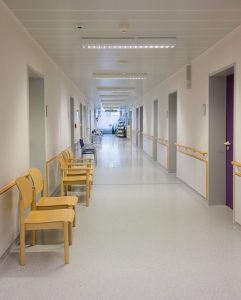Keeping A&E usage to a minimum – the comms challenges
Over the Christmas break I took a trip to A&E. I wasn’t shopping for myself – my mother slipped buying provisions for the festive family feeding frenzy, and broke both of her wrists.
Well aware of recent newspaper headlines, we braced ourselves for a bleak midwinter hospital scene; scores of groaning patients, a few overworked doctors and nurses, and a lot of waiting.
What actually happened was that our patient was seen  within five minutes, given a diagnosis after a
within five minutes, given a diagnosis after a
couple of hours, and operated on within 48 hours (on Christmas Eve, no less). Mother Wristmas was given her own room, and was even visited by carol singers at one point – the only sound to be heard on an otherwise silent night at The Lister Hospital in Stevenage.
So where was all the mayhem?
Mum didn’t respond very positively to my suggestion that she was lucky to have broken her wrists when she did, but due to the way most of us use A&E, she was. She had her festive fall in the middle of the day, on a Tuesday. We assume she was sober. Statistics show that 70% of A&E visits at the weekend are alcohol-related. This is, therefore a department which spends a huge chunk of its time treating problems which are self-induced.
 For various tedious reasons, drinking is less common on a Tuesday afternoon. In addition, Christmas may also have had an effect on the mind-set of those who may have normally presented with less consequential problems: ‘I won’t be able to see a doctor quickly so close to Christmas’. As such, they may have unwittingly used A&E the way it should be – sparingly.
For various tedious reasons, drinking is less common on a Tuesday afternoon. In addition, Christmas may also have had an effect on the mind-set of those who may have normally presented with less consequential problems: ‘I won’t be able to see a doctor quickly so close to Christmas’. As such, they may have unwittingly used A&E the way it should be – sparingly.
Once the alcohol-related and non-emergency cases are removed, A&E runs much more smoothly. Reducing the burden of these two problems on A&E would greatly benefit the service. Both of these issues present comms challenges, so what can be done?
Keeping the E in A&E
NHS England and the Royal College of Emergency Medicine warned the public only to use A&E in genuine emergencies over the Christmas period, as the way the holidays fell they expected pressure on services on the two holiday weekends. Again, weekends were a particular worry because of the impact of alcohol on A&E. Communicating via news broadcasts (radio, television and online, in this case) around specific pressure points has value, as it may put off the non-emergency visitors in the short term.
For a prolonged change to the public’s perceptions and use of A&E, work is needed to provide a viable alternative for the bed clogging minor injuries that currently take up so many hours on the ward. The introduction of the 111 service has been one such attempt to ease pressure on A&E. It has had a lot of teething issues, and has been met with serious criticism, but it is this kind of service signposting which is needed to help people make the right decision, and minimise the number of cases who use A&E as the entrance point to our health service.
 Alcohol and A&E – a losing battle
Alcohol and A&E – a losing battle
Without sounding defeatist, persuading the British public to drink less may be a non-starter. There was something of an admission to this effect when Dame Sally Davies last week tightened guidelines on alcohol consumption in the UK, but at the same time said that alcohol consumption brings risk at any level, and that it is down to the individual consumer how much risk they want to take. Extremely logical guidance, but also advice which renders the guidelines themselves slightly moot.
Davies’s framing of the latest expert consensus on alcohol suggested that this guidance was something that had to be said, rather than something the DoH expects will change behaviour. Some might call this refreshingly realistic, but it also indicates that A&E’s comms war may be best fought on the front of non-emergency admissions.
– By George H.

